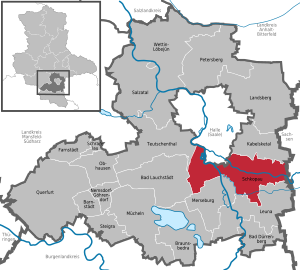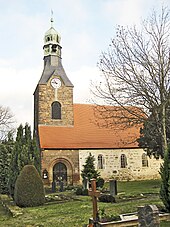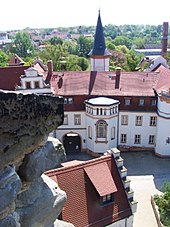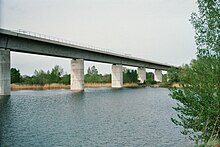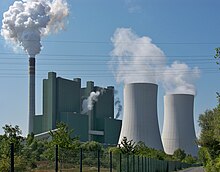Schkopau
| coat of arms | Germany map | |
|---|---|---|
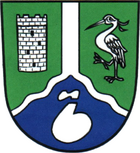
|
Coordinates: 51 ° 23 ' N , 11 ° 58' E |
|
| Basic data | ||
| State : | Saxony-Anhalt | |
| County : | Saalekreis | |
| Height : | 98 m above sea level NHN | |
| Area : | 99.74 km 2 | |
| Residents: | 10,926 (Dec. 31, 2019) | |
| Population density : | 110 inhabitants per km 2 | |
| Postal code : | 06258 | |
| Primaries : | 0345 (Burgliebenau, Döllnitz, Hohenweiden, Lochau) , 03461 (Knapendorf, Korbetha, Luppenau,) , 034204 (Ermlitz) , 034605 (Raßnitz, Röglitz) , 034639 (Wallendorf) | |
| License plate : | SK, MER, MQ, QFT | |
| Community key : | 15 0 88 330 | |
| LOCODE : | DE SKO | |
| NUTS : | DEE0B | |
| Address of the municipal administration: |
Schulstrasse 18 06258 Schkopau |
|
| Website : | ||
| Mayor : | Torsten Ringling | |
| Location of the community of Schkopau in the Saalekreis | ||
Schkopau is a municipality in the Saalekreis in Saxony-Anhalt . The place Schkopau is about 6 km north of Merseburg and 11 km south of Halle (Saale) . The longest railway bridge in Europe, the Saale-Elster valley bridge , runs over the territory of Schkopau.
geography
location
In the north, Halle and Kabelsketal border on Schkopau, in the east Schkeuditz in the district of Northern Saxony , in the south Leuna and Merseburg and Bad Lauchstädt and Teutschenthal in the west.
The Saale and its right tributaries, White Elster and Luppe, form the Saale-Elster-Aue , which takes up part of the municipality.
Community structure
| Locality | Residents | Districts |
|---|---|---|
| Burgliebenau | 384 | Burgliebenau |
| Dollnitz | 1,425 | Dollnitz |
| Ermlitz | 1,592 | Ermlitz, Oberthau and Rübsen |
| Hohenweiden | 547 | Hohenweiden, Neukirchen, Rattmannsdorf, Rockendorf and Röpzig |
| Knapendorf | 540 | Bündorf, Dörstewitz and Knapendorf |
| Korbetha | 250 | Korbetha |
| Lochau | 1,017 | Lochau and Wesenitz |
| Luppenau | 548 | Löpitz, Lössen and Tragarth |
| Rassnitz | 946 | Pritschöna, Raßnitz and Weßmar |
| Röglitz | 333 | Röglitz |
| Schkopau | 3.141 | Kollenbey , Schkopau |
| Wallendorf (Luppe) | 793 | Pretzsch, Wallendorf and Wegwitz |
The villages of Schkopau (clickable map):
history
The area around Schkopau was settled in prehistoric times. In the district of Raßnitz during the early Bronze Age around 1800 BC. Built by members of the Bornhöck culture in Aunjetitz . With a diameter of 65 m, it was one of the largest burial mounds in Central Europe until its destruction in the 19th century .
Schkopau was first mentioned in a document in 1177. Presumably there was a Carolingian fortification as early as the ninth century. Schkopau belonged until 1815 merseburgischen hochstiftlich- Office Merseburg , which since 1561 under electoral Saxon stood sovereignty and between 1656/57 and 1738 for Sekundogenitur -Fürstentum Saxe-Merseburg belonged. The neo-renaissance castle , which is now used as a hotel, has a keep from the 16th century. The village church Schkopau was built from 1732 to 1734 .
See also the list of cultural monuments in Schkopau
The decisions of the Congress of Vienna the place came in 1815 to Prussia and in 1816 the county Merseburg in the administrative district of Merseburg of the Province of Saxony assigned to which he belonged until 1,952th During the district reform in the GDR, the place came to the Merseburg district in the Halle district in 1952 , which became part of the Merseburg-Querfurt district in 1994 and the Saale district in 2007 .
The region was heavily influenced economically by the establishment of Buna-Werke GmbH Schkopau in 1936/1937. It was the world's first synthetic rubber plant and manufactured a range of other chemical products. During the Second World War , the Buna works had a high proportion of foreign workers, including prisoners of war. There was also a labor education camp in Schkopau . The Buna works were bombed by the US Air Force in July and especially in November 1944 . After corresponding production failures, the partial reconstruction took place. The city of Schkopau was also affected by the attacks on the neighboring plant. 82 explosive bombs detonated in Schkopau and the region up to Kollenbeyer Holz . The population was allowed to share one of the air raid shelters in the plant.
→ Main article Air strikes on the Buna plant in Schkopau
On April 14, 1945, the city and the Buna works were occupied by US troops , who were replaced by the Red Army in early July .
In the course of the flight and expulsion of Germans from Central and Eastern Europe , Catholics also settled in Schkopau, so that a Catholic church was established. It originated in a barracks of the former Reich Labor Service , was born on 22 August 1948 opened and after the holy Anna named. It was profaned on November 22, 2015 .
In the GDR , the Bunawerke were the center of chlorine chemistry with carbide production . Carbide was used to produce ethyne (acetylene), from which a large number of chemical products (e.g. PVC ) were obtained using Reppe chemistry (as an alternative to petrochemistry ) .
After reunification, the factory facilities were largely taken over by the Dow Chemical Company .
Incorporations
The community Luppenau was formed on July 1, 1950. Further incorporations took place at the same time in the area of the current municipality of Schkopau. On August 1, 2004 a total of eight communities were incorporated. Three of them ( Döllnitz , Hohenweiden and Lochau) moved from the Saalkreis to the Merseburg-Querfurt district. On January 1, 2005, the communities Knapendorf and Luppenau were added. The previous Saale-Elster-Aue administrative association ceased to exist on January 1, 2005 . On January 1, 2010 Wallendorf (Luppe) was incorporated into Schkopau from the Leuna-Kötzschau administrative community .
| Former parish | date | annotation |
|---|---|---|
| Bündorf | 07/01/1950 | Incorporation to Knapendorf |
| Burgliebenau | 08/01/2004 | |
| Dollnitz | 08/01/2004 | |
| Dörstewitz | 07/01/1950 | Incorporation to Knapendorf |
| Ermlitz | 08/01/2004 | |
| Hohenweiden | 08/01/2004 | |
| Knapendorf | 01/01/2005 | |
| Kollenbey | 07/01/1950 | |
| Korbetha | 08/01/2004 | |
| Lochau | 08/01/2004 | |
| Löpitz | 07/01/1950 | Merger with Lössen and Tragarth zu Luppenau |
| Loosen | 07/01/1950 | Merger with Löpitz and Tragarth zu Luppenau |
| Luppenau | 01/01/2005 | |
| Neukirchen | 07/01/1950 | Incorporation to Hohenweiden |
| Oberthau | 07/01/1950 | Incorporation to Ermlitz |
| Pretzsch | 04/01/1937 | Incorporation to Wallendorf |
| Pritschöna | 07/01/1950 | Incorporation to Raßnitz |
| Rassnitz | 08/01/2004 | |
| Rattmannsdorf | 07/01/1950 | Incorporation to Hohenweiden |
| Rockendorf | 07/01/1950 | Incorporation to Hohenweiden |
| Röglitz | 08/01/2004 | |
| Röpzig | 07/01/1950 | Incorporation to Hohenweiden |
| Tragarth | 07/01/1950 | Merger with Löpitz and Lössen zu Luppenau |
| Wallendorf (Luppe) | 01/01/2010 | |
| Wegwitz | 04/01/1937 | Incorporation to Wallendorf |
| Wesenitz | 08/01/1938 | Incorporation to Lochau |
| Weßmar | 07/01/1950 | Incorporation to Raßnitz |
politics
Municipal council
The municipal council consists of 27 members and has been composed as follows since the municipal council election on May 26, 2019:
- Christian Democratic Union of Germany: 7 seats
- Social Democratic Party of Germany: 5 seats
- Alternative for Germany: 4 seats
- The left: 3 seats
- Alliance 90 / The Greens: 2 seats
- Pro-Döllnitz voters' association: 2 seats
- Initiative per citizen: 2 seats
- Free Democratic Party: 1 seat
- Schkopau volunteer fire brigade cultural association: 1 seat
- Individual applicant Pomian: 1 seat
mayor
On October 9, 2011, all districts of the community of Schkopau elected a new mayor for the first time. Since no applicant was able to win over 50% of the votes straight away, a runoff election was necessary. Andrej Haufe (CDU) and Peter Richter (independent) met in the runoff election, with Andrej Haufe (CDU) winning the election with 54.10% of all votes cast. The turnout was 29.70%, around ten percentage points below the turnout on October 9, 2011. Andrej Haufe took up his post as the new mayor of Schkopau in February 2012.
Andrej Haufe's term of office ended on January 31, 2019. His successor, Torsten Ringling, who was elected in the run-off on October 28, 2018 with 73.39 percent of the votes cast, took office on February 1, 2019.
coat of arms
In 1997 a coat of arms for the municipality of Schkopau was approved. After the dissolution and reorganization of the community on August 1, 2004, the Schkopau community does not have a national emblem according to the main statute of April 30, 2010.
The municipality of Schkopau has had one or two logos (as a whole) since 2011. The elements of the logo represent a reference to concise points in the municipality. On the one hand, these are the main colors of the coats of arms existing in the districts. If you look at these, you can see the three dominant colors blue, green and gold, which served as the basis for the logo. In search of a symbol that characterizes the past and future, the "Buna piston" (plastic and elastane from Schkopau) was used in a modern form, as the economy is the basis for the development of Schkopau.
Memorials
- Tombs in the cemetery of the local part Burgliebenau four Polish and Soviet women and men during the Second World War, victims of forced labor were
- Grave site in the New Cemetery for 45 women, children and men who were abducted to Germany during the Second World War and who were victims of forced labor in the Buna works
- Graves in the local cemetery for 29 victims of forced labor from different nations
Attractions
- Saale-Elster-Aue with the Saale-Elster valley bridge , Europe's longest railway bridge
- Schkopau Castle in neo-renaissance style with castle park
- Schkopau village church
Economy and Infrastructure
traffic
Schkopau station is on the Halle – Bebra railway line, which opened in 1846 . The regional trains on the RB20 Halle – Eisenach line stop every hour in each direction in Schkopau. The operator Abellio has been driving wheelchair-accessible Talent 2 vehicles since December 2015 . The three platforms of the station were rebuilt in 2017 and raised for level access. With the construction of elevators, the central platform between the tracks should also be accessible without steps from 2018. Chemical Park Buna is located on the railway line Merseburg-Schafstädt with Buna works another break point, but which is no longer operated in regular service.
The community of Schkopau lies on the B 91 (Halle (Saale) –Merseburg – Weißenfels – Zeitz).
In addition to being served by some bus lines, Schkopau is also served by HAVAG's tram line 5 ( Halle-Ammendorf-Bad Dürrenberg tram route ).
Established businesses
Schkopau is best known for the former VEB Chemische Werke Buna . During the GDR era, for example, a tower on the Elbe bridge near Vockerode on the Berlin-Hof transit highway carried the large-format illuminated advertising Plaste and Elaste from Schkopau (created by Siegfried Berthmann), which is now in the German Historical Museum in Berlin. The local chemical park was taken over by Dow Chemical after reunification . The Trinseo (formerly spun Styron Germany GmbH (from Dow Chemical)) produces synthetic rubber in Schkopau (cold-cured polymers) and markets it under the brand name Buna SB. The headquarters of the Central German Railway (MEG) is also in Schkopau.
Schkopau is now also with the power plant Schkopau a lignite power plant of Uniper Kraftwerke GmbH .
Personalities
Sons and daughters of the place
- Wolf Heinrich Ernst von Natzmer (1698–1770), Saxon-Weissenfeld governor and manor owner
- Christian Friedrich Schmidt (1741–1778), philosopher and Lutheran theologian, born in Röglitz
- Ernst Ludwig Herrfurth (1830–1900), Prussian statesman, born in Oberthau
- Hermann Gocht (1869–1938), radiologist, orthopedist and university lecturer
- Thilo von Trotha (1882–1969), DNVP member of the Reichstag, owner of the Schkopau manor
- Rainhard Lukowitz (* 1950), FDP politician
- Jochen Habekuss (* 1950), soccer goalkeeper
- Peter English (* 1962), football player
Persons connected to Schkopau
- Albert Fraustadt (1808–1883), Protestant pastor and author in Bündorf
- Paul Juckoff (1874–1936), sculptor, lived in Schkopau
- Kurt Biedenkopf (* 1930), politician, spent several years of his childhood (1938 to 1945) in Schkopau
Trivia
- The advertising text Plaste und Elaste from Schkopau , which could also be read on a bridge over the transit route from Rudolphstein to West Berlin , symbolized the subtleties of the different terms used in the former GDR compared to the West German usage at the time. B. instead of plastics and elastics, the terms plastic or, alternatively, plastic were common.
Web links
Individual evidence
- ↑ State Statistical Office Saxony-Anhalt, population of the municipalities - as of December 31, 2019 (PDF) (update) ( help ).
- ^ Karlheinz Blaschke , Uwe Ulrich Jäschke : Kursächsischer Ämteratlas , Leipzig 2009, ISBN 978-3-937386-14-0 , p. 84 f.
- ^ The district of Merseburg in the municipal directory 1900
- ↑ Churches of the Catholic Parish of St. Norbert Merseburg , accessed on August 6, 2018.
- ↑ Federal Statistical Office (Ed.): Municipalities 1994 and their changes since 01.01.1948 in the new federal states . Metzler-Poeschel, Stuttgart 1995, ISBN 3-8246-0321-7 .
- ^ StBA: Changes in the municipalities in Germany, see 2004
- ↑ StBA: Changes in the municipalities in Germany, see 2005
- ↑ StBA: Area changes from January 01 to December 31, 2010
- ↑ State Statistical Office Saxony-Anhalt
- ↑ Mayoral election 2011
- ^ Runoff election for the 2011 mayoral election
- ^ Official Journal of the Municipality No. 9/2010
- ↑ Logos of the community of Schkopau
- ↑ Saxony-Anhalt station program. Retrieved November 7, 2017 .

